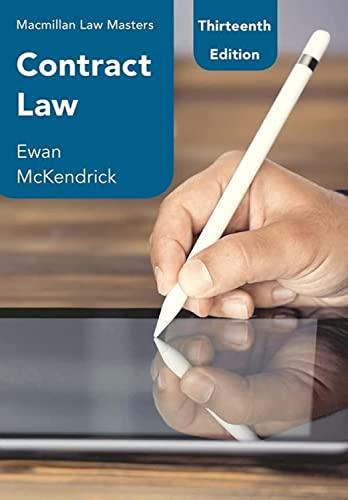Question
Gouge v. Three Tops Investment Holdings Inc., [1994] O.J. No. 751 (G.D.) This is a cash bar case but one with a slightly problematic finding
Gouge v. Three Tops Investment Holdings Inc., [1994] O.J. No. 751 (G.D.)
This is a cash bar case but one with a slightly problematic finding as to foreseeability. A hotel staged a banquet dinner for a trade union of which the plaintiff patron was a member. The plaintiff drank 16 to 19 ounces of rye during the dinner. Towards the end of the evening the waitresses, who did not serve alcohol, noticed the patron was drunk and informed the bartender who decided not to serve him further. Members of the hotel staff overheard a co-worker pleading with the plaintiff to accept a ride home from her. The co-worker eventually convinced him and the staff observed as the two left the banquet room together. Outside, the plaintiff suddenly changed his mind and got on his motorcycle. He was in a serious accident moments later.
As in Porter, the Court found that by using a cash bar, the hotel had deprived itself of the means to discharge its duty to monitor consumption. The hotel was held 5% liable for the accident.
The reasoning as to cash bars in Gouge was considered with approval by the Supreme Court of Canada in Stewart v. Pettie. However, the finding on foreseeability in Gouge appears to have been implicitly overruled by that case. In Gouge, Pardu J. found that "it was reasonable for the hotel staff to conclude that the plaintiff had accepted the offer of a ride home ... when he left the banquet room". According to Stewart v. Pettie that should have ended the question of liability for the hotel. However, Pardu J. found the hotel was liable anyway on the basis that "the bizarre behaviors of the plaintiff in suddenly changing his mind and refusing a ride in the parking lot [was] a direct result of his extreme intoxication". It is submitted that the same set of facts now would be decided in favour of the hotel as Stewart v. Pettie could be used to argue that at the time the plaintiff left, there was no foreseeable risk for the hotel to guard against.
Questions: The facts (5 marks)
1. The issue(s) Make sure it is in question format.
2. The court's decision
3.The court's reasoning supporting the decision
4. Conclusion: Do you agree with the outcome? Why or why not? Justify your answer. )
- Agree/not )
- Why or why not )
- Your own personal justification/rationale expanding on why or why not
Step by Step Solution
There are 3 Steps involved in it
Step: 1

Get Instant Access to Expert-Tailored Solutions
See step-by-step solutions with expert insights and AI powered tools for academic success
Step: 2

Step: 3

Ace Your Homework with AI
Get the answers you need in no time with our AI-driven, step-by-step assistance
Get Started


